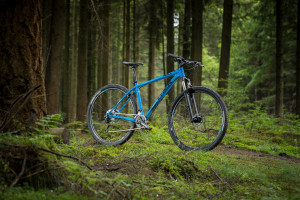
- Supple suspension at either end maximises grip and comfy
- Excellent, confident handling from a progressively shaped frame
- Build kit isn't the flashest, but works well as a whole
- Bigger or more powerful riders might find some frame flex
- Lighter, better specced rivals are available for the money
Lapierre's XR729 is a really well-balanced cross country and marathon machine that's impressively adept when it comes to descending, though full-on race heads might be put off by a weight that's a touch on the higher side when you consider the price tag.
- Buyer's guide to mountain bikes: get the best MTB for you and your budget
- When should you replace your bicycle helmet? We asked the experts...
- Review: Specialized Women's Epic Comp Carbon
Lapierre might not be your first thought when it comes to cross-country race and marathon bikes, with their enduro and trail offerings being much better known in the UK. However, they've always had some good distance machines in their lineup, such as the clever ProRace hardtail I rode last year. The XR range is the full suspension part of the short travel family and this 729 sits in the middle of the range.
All the XR bikes get a full carbon fibre frame using 29" wheels and 100mm of travel at either end, the rear using a Horst link style four-bar system. Boost 148 rear hub spacing is standard at the rear, along with a tooled through axle. There's some neat detailing too, with a special compartment near the bottom bracket that you can hide a Shimano Di2 battery in, should you go down the route of electric gear shifting and you can pop an internally routed dropper in there too if you fancy.
By cross-country standards, the frame geometry is pretty damn progressive, with the large frame I tested having a reach of 441mm and an effective top tube of 620mm. That's nice and spacious, allowing the use of a small (by cross-country race bike standards) 70mm stem and respectably wide 720mm flat bars.
At 69º, the head angle is on the slacker side for descending confidence and the effective seat angle of 74.5º helps keep your weight over the front when climbing in the saddle, allowing you to clean technical or really steep sections with less body movement and hence fatigue. Combined with a decent reach, you get a really nice balance of being able to get into a head down, aggressive riding position but still be able to ride the bike as a pilot, not a passenger when the going gets a bit rougher.
Superb suspension
Up front, the RockShox SID fork uses the new sealed Charger damper and it's amazing how much the more refined damping benefits the bike, despite the relatively limited amount of travel. It gives good sensitivity at the start of the stroke with plenty of support at the end. That means that, instead of running it so stiff it's essentially a glorified rigid fork, you can set it up like a normal fork and reap the benefits of traction and comfort.
That's also complimented by the back end, which is sensitive off the top of the travel for good grip without being too soggy when you get back on the pedals. There's a decent ramp up through the travel which allows you to get support and drive through the turns and launch yourself into the rough and tumble without worrying about violently bottoming out.
It feels a bit plusher and more trail-orientated than most cross country rigs, which will be of benefit on long, all day rides and races, but some mind find it a bit too soft for putting the hammer down on short courses. If that's the case for you, then you'll want to make plentiful use of the RockShox Deluxe RL shock's bar mounted lockout. It's also linked to the fork so you can get bob-free sprinting at the touch of a (slightly stiff to use) cable operated switch.
A hint of flex
I'm not the beefiest of riders at 65kg but there was definitely a hint of flex and twist through the back end when really getting on the power or wrestling the bike out of turns. I didn't find it an issue - in fact it felt pleasingly forgiving and held a line across cambers when others might have been pinged off - but you might notice it a bit more if you're a heavier built or more powerful rider. Despite all the bikes in the range using a single chainring drivetrain, the frame has a narrower main pivot to allow a twin ring setup, which can't help back end stiffness. I blame European 2x tastes for that one.
Kit wise, the Lapierre XR729 has a quality if not mind-blowingly good value selection of bits. The SRAM GX Eagle drivetrain has 12 ratios across a more than adequate 10-50T range and it delivers snappy if not always smooth shifts. With the addition of a carbon fibre armed SRAM X1 chainset sat in a Press Fit (boo!) bottom bracket, there's only a marginal weight penalty over more expensive SRAM Eagle groups, though longevity is as yet untested.
SRAM also provides the stoppers in the form of the Level TL brakes which have plenty of power for the task at hand and decent feel too. The Lapierre branded carbon post does the trick just fine, though the Fizik saddle atop it will very much split opinion, with a rather flat shape that won't suit all bottoms. The 720mm RaceFace carbon flat bars are good too see, though I'd ditch the overly fat lock on foam grips for something silicone as I found they gave me arm pump with my admittedly small hands.
It's really nice to see a quality wheelset in the form of the Mavic Crossmax Elite. It might be the cheapest of the range, but it's properly UST tubeless and very tough. It might feel a bit narrow if you prefer fatter rubber and there are definitely more precise wheelsets out there, but it's got a great ride quality and it more than up to the task at hand.
The tubeless ready, twin compound Maxxis rubber is decent too, with a slightly more aggressive Ardent 2.25" up front and a fast rolling Ikon 2.2" out the back - both in a fetching gumwall.
Summary
While it's not exactly a trail-bike by any stretch of the imagination, the XR 729 really impressed me with an excellent balance of outright pace and descending poise. Thanks to well thought out geometry, it's as happy pushing the pace on climbs as it is trying to gain tenths back on a descent. Okay, true race heads might find the back end a little soft in terms of power transfer, but it's a supple ride that doesn't leave you feeling as badly beaten as many cross-country race rigs often do.
At 11.8kg for our large - not lardy by any means - there are a few rivals that pip it to the post on weight for the price. The kit inevitably looks a bit low rent if you compare it against direct sales rivals too. That said, it is all well thought out stuff with no obvious weak spots and the frame offers handling is a step above staid-feeling, traditionally steep and twitchy rivals without feeling lazy.
If you're after a capable and rapid marathon machine or a comfy cross-country racer that'll keep pace on the descents, you should place the XR 729 in the starting row.
About the bike
State the frame material and method of construction. List the components used to build up the bike.:
FrameXR 29" FULL CARBON 100mm travel PRESSFIT, BOOST, METRIC, THRU AXLE
ForkROCKSHOX SID RL 29" BOOST SOLO AIR100mm+ ONELOC
Shock AbsorberROCKSHOX DELUXE RL REMOTE 190X40 DEBONAIR MM
HeadsetFSA ORBIT 1.5Z SC NO.57SC
Bottom bracketSRAM PRESS FIT MTB (89/91.5)
CranksetSRAM X1 CARBON EAGLE DIRECT MOUNT BOOST XSYNC 32T 170mm (S), 175mm (M,L,XL)
StemLAPIERRE ST148A 7050 ALLOY 7° Ø: 31.8mm L: 60mm (S, M) / 70mm (L, XL)
SeatpostLAPIERRE ST66-TC CARBON Ø: 31.6mm L: 400mm
HandlebarRACEFACE NEXT CARBON W: 720mm Ø: 31.8mm
Rear derailleurSRAM X01 EAGLE TYPE 2.1 CARBON 12s
BrakesSRAM LEVEL TL
ShiftersSRAM GX EAGLE
SaddleFIZIK TUNDRA M5
WheelMAVIC CROSSMAX ELITE 29" 15x110/ 12x148
SprocketSRAM XG 1275 12s 10-50T
TiresMAXXIS ARDENT 2.25 / MAXXIS IKON 2.20 FOLDING SKINWALL 60TPI TLR
SizeS,M,L,XL



















Add comment